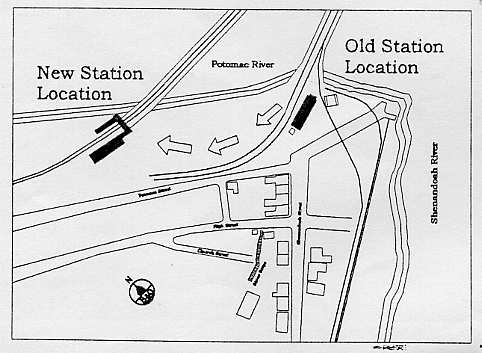
Baltimore & Ohio
Harpers Ferry Railroad Station

Harpers Ferry Station with original tower in 1939 ..
[National Park Service photo]
Station drawings.. Delineated by Paul H. Girouard, Xenia Olah, Kris Key and Walton Stowell II, 2002.
[The Historic American Engineering Record, National Park Service]
Station drawing.. Hand drawn by Kris Key.. Delineated by Kris Key, 2002.
[The Historic American Engineering Record, National Park Service]
Harpers Ferry from Maryland Heights
[Photo by Rob Brzostowski]
The Baltimore & Ohio Railroad, conceived in the 1820s by the merchants of Baltimore as a way to capture a share of the burgeoning domestic trade with the New West, reached Harpers Ferry in December 1856. Locked in a sometimes bitter race with the Chesapeake & Ohio Canal Company, the railroad reached the city of Wheeling on the Ohio River in 1852. Although it was considered a marvel of surveying and construction in its time, the B&O's main line from Baltimore to Wheeling incorporated numerous impediments to efficient operation - grades too steep, bridges too light, and curves too sharp. These conditions were the consequence of the need to select initial routes and construction methods based on financial constraints rather than engineering ideals. Compromises were made in order to complete the line quickly to the established end point, thereby initiating a flow of revenue. With the capital thus generated, the railroad company could go back and make improvements along the line to increase the line's capacity and to decrease maintenance costs.
The station at Harpers Ferry, West Virginia, stands as a symbol of this relationship between railroad engineering and railroad economics. Attributed to a design by B&O architect E. Francis Baldwin, the station was built as the finishing touch of a series of improvements made to the mainline at Harpers Ferry beginning in 1892.
The station was moved from its original location to its present site in 1931 during a second round of improvements. Both sets of improvements significantly modified the historic landscape of Harpers Ferry.

In 1950, the station's distinctive two-story interlock tower was dismantled during a period of financial crisis for the B&O. The station survived the B&O's takeover by the C&O Railway in the 1960s, and eventual inclusion into the CSX Corporation in the 1980s.
In 2001, the National Park Service acquired the station. Throughout these periods, the station has continued to serve the region's rail passengers. Today, it is a stop on both the Amtrak system and the Maryland Rail Commuter line.
Documentation of the Harpers Ferry Station was undertaken during the summer of 2002, and is part of the Historic American Engineering Record (HAER), a long-range program which documents historically significant engineering and industrial works in the United States.
HAER (Eric DeLony, Chief) is administered by the Historic American Buildings Survey/ Historic American Engineering Record (E. Blaine Cliver, Chief), a division of the National Park Service, U.S. Department of the Interior. Harpers Ferry National Historical Park (Don Campbell, Superintendent) sponsored the project. Park staff Peter F. Dessauer, Bill Hebb, Matthew Graves and Stephen Capone provided assistance.
The field work, measured drawings, historical report and photography were completed under the direction of Christopher Marston, Project Leader. The field team consisted of Field Supervisor Walton D. Stowell II (Savannah College of Art & Design), architects Kristian S. Key (Texas Tech University), Paul M. Girouard (University of Illinois at Chicago), and Xenia Olah (ICOMOS-Romania). Park archeologists John Ravenhorst and Mia Parsons produced the site plan, and Andrew Lee wrote the history. HAER photographer Jet Lowe produced the large-format photographs. Rob Brzostowski (Shepherd College) served as project volunteer.